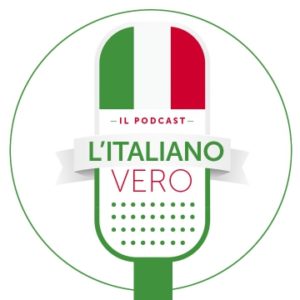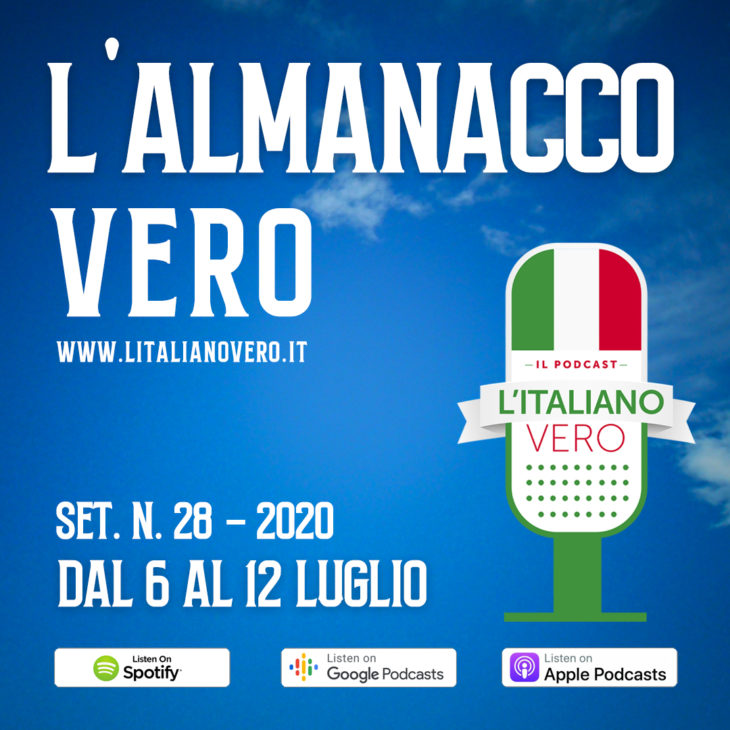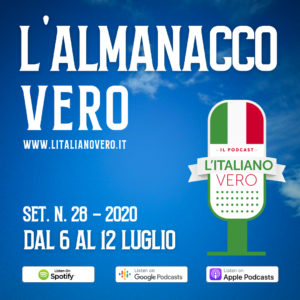L’Almanacco Vero – sett. 28 dal 6 luglio al 12 luglio ’20
Blog in italiano – tempo di lettura: 6 min
Blog in English – reading time: 6 min
________________
Blog in italiano
Cari amici, un grande ciao da tutti noi!
Ringraziamo i nuovi patron Jack e Martha; ed anche Gunther da Colonia che ci ha mandato un bel messaggio e ci ha fatto una donazione.
Mentre Cubo e Paolo sono sempre al lavoro, io sono ancora al mare e la mia vacanza va a gonfie vele! (nel migliore dei modi, ottimamente), anche se tra pochi giorni a malincuore (con rammarico, controvoglia) dovrò tornare a casa.
Partiamo con la nostra carrellata di eventi:
7 luglio
1881 – Carlo Collodi pubblica la prima puntata delle Avventure di Pinocchio: storia di un burattino: inizialmente aveva scritto soltanto otto capitoli, poi, visto l’immediato successo, continuò la serie fino al 1883, quando diede alle stampe il romanzo Le avventure di Pinocchio, un grande classico della letteratura per ragazzi.
La storia, ambientata in Toscana, poco prima dell’Unità d’Italia, è quella di un burattino ricavato da un tronco di legno da un povero falegname di nome Geppetto, che non ascolta gli insegnamenti e finisce sempre per cacciarsi nei guai, con un debole per le bugie che gli fanno crescere il naso. Attraverso una serie di disavventure riesce finalmente a mettere giudizio, ascoltando gli insegnamenti della Fata Turchina e del Grillo Parlante. e a meritare di diventare un bambino in carne ed ossa.
Modi di dire:– Avere il naso lungo/avere le gambe corte = dire le bugie.
Come dice la Fata Turchina: “Le bugie, ragazzo mio, si riconoscono subito! Vi sono le bugie che hanno le gambe corte, e le bugie che hanno il naso lungo: la tua per l’appunto è di quelle che hanno il naso lungo.”
Ancora oggi, è fonte inesauribile per scrittori, registi e disegnatori: dal film d’animazione della Disney (1940) al Pinocchio (2002) recitato da Roberto Benigni e all’ultimo, uscito pochi mesi fa con la regia di Matteo Garrone, ancora con Benigni, questa volta nei panni di Geppetto.
1901 – Nasce Vittorio De Sica (118 anni fa): Nato a Sora (in provincia di Frosinone) e registrato all’anagrafe come Vittorio Domenico Stanislao Gaetano Sorano De Sica, con la carriera di attore, regista e sceneggiatore, fece del neorealismo cinematografico un modello universale riconosciuto in tutto il mondo e in ogni epoca. Mecenate (patrizio romano del I sec. a.C. promotore degli artisti e dei letterati latini e oggi per antonomasia, chi promuove e sostiene finanziariamente l’attività artistica) di grandi dive, del calibro di Magnani e Loren (portate entrambe all’Oscar), fu il primo italiano a trionfare nell’ambita notte degli Academy Awards.
Formatosi nel teatro e con il cinema muto degli anni Venti, si impose sulla scena (seppur giovanissimo, si fece subito notare per il suo talento e fu immediatamente considerato uno dei protagonisti indiscussi del cinema) grazie alla commedia Gli uomini, che mascalzoni… del 1932, ricordata anche per la canzone “Parlami d’amore Mariù”, portata al successo dallo stesso De Sica.
Quando negli anni Quaranta decise di mettersi dietro la cinepresa, non ci fu storia (o non ci fu gara, cioè non temette il confronto o il paragone con altri, perché era evidente la sua superiorità: ad esempio quando il brasiliano Ronaldo entrava in campo, non c’era storia per i difensori!).
Nel 1946 e nel 1948 sfornò (fece uscire, realizzò) i primi due di una lunga serie di capolavori, rispettivamente Sciuscià e Ladri di biciclette, premiati entrambi con l’Oscar come “miglior film straniero”. Nel 1960 fece entrare Sophia Loren nel mito dei grandi di Hollywood con La Ciociara, che gli valse l’Oscar come “migliore attrice protagonista”.
L’ambita “statuetta” finì di nuovo tra le sue mani nel 1965 con Ieri, oggi, domani (con la coppia d’oro Mastroianni-Loren) e cinque anni dopo con Il giardino dei Finzi-Contini (tratto dall’omonimo romanzo di Giorgio Bassani).
Innamorato della lingua e della tradizione musicale partenopea, ne fu profondamente influenzato in molte pellicole, tra cui L’oro di Napoli e Matrimonio all’Italiana.
Si spense in Francia il 13 novembre 1974 e le spoglie vennero tumulate nel cimitero monumentale del Verano a Roma.
11 luglio
1934 – Nasce Giorgio Armani (85 anni fa): Nato a Piacenza, è uno dei più quotati stilisti internazionali e tra gli ambasciatori dell’alta moda italiana nel mondo. Inizia la sua carriera lavorando come vetrinista e commesso per la Rinascente fino al 1965. Dieci anni dopo, nel 1975 realizza la sua prima collezione e fonda lo storico marchio che porta il suo nome. Da allora l’azienda è cresciuta in modo esponenziale, lanciando anche linee di occhiali, profumi, arredo e complementi, con boutique in tutto il mondo, con lo stile inconfondibile, per la classe e l’eleganza delle sue creazioni.
Ha disegnato i costumi di numerose star del cinema e per film famosi, come “Gli intoccabili” (1987), ha vestito anche la nazionale italiana ai giochi olimpici in diverse edizioni. Nel 2014 riceve il Compasso d’oro alla carriera, il più antico riconoscimento d’Europa nel settore del design.
1982 L’italia vince i mondiali di Spagna dell’82 : “Campioni del Mondo”, ripetuto tre volte dal noto telecronista Nando Martellini, accompagna i primi momenti di grande gioia degli italiani al termine della finale dei Mondiali di calcio di Spagna 1982. La finale non inizia nel migliore dei modi per l’Italia che al 7′ vede l’uscita forzata dal campo di Graziani per un infortunio alla spalla. Al suo posto subentra Altobelli il quale tenta, pochi minuti dopo, di servire in area Conti il quale però viene atterrato dal difensore tedesco Briegel: per l’arbitro Arnaldo Coelho è calcio di rigore. Sul dischetto si presenta il difensore Cabrini che sbaglia calciando il pallone fuori, alla sinistra del portiere Schumacher.
Gli uomini di Bearzot non si perdono d’animo e nel secondo tempo trovano il gol del vantaggio con Rossi, su assist di Gentile, grazie a una punizione battuta in fretta a centrocampo. Poco dopo un contropiede di Scirea viene concretizzato da Tardelli il quale esulta con il suo famoso urlo correndo verso la metà campo, agitando i pugni contro il petto, con le lacrime e con il grido a ripetizione «gol!». A pochi minuti dallo scadere Altobelli realizza il terzo gol per gli Azzurri a seguito di un contropiede orchestrato da Conti. Da qui al fischio finale la Germania Ovest riesce solo a segnare il gol della bandiera con Breitner che fissa il punteggio sul 3-1, risultato che permette all’Italia di vincere il suo terzo titolo mondiale dopo 44 anni dal precedente. Il capitano azzurro Zoff alza la coppa e diventa, a 40 anni e 133 giorni, il più anziano vincitore di un mondiale.
12 luglio
1963 – Nasce il marchio DOC per i vini (56 anni fa): Con le finalità di valorizzare un prodotto di qualità, interamente italiano e rappresentativo di una specifica area territoriale.La denominazione di origine controllata è utilizzata in enologia per certificare la zona di origine della raccolta delle uve utilizzate per la produzione del prodotto sul quale è apposto il marchio. Esso viene utilizzato per designare un prodotto di qualità e rinomato, le cui caratteristiche sono connesse all’ambiente naturale ed ai fattori umani e rispettano uno specifico disciplinare di produzione.
Tali vini, prima di essere messi in commercio, devono essere sottoposti in fase di produzione ad una preliminare analisi chimico–fisica e ad un esame organolettico che certifichi il rispetto dei requisiti previsti dal disciplinare; il mancato rispetto dei requisiti ne impedisce la messa in commercio con la dicitura DOC.
Dal 2010 la classificazione DOC, così come la DOCG, è stata ricompresa nella categoria comunitaria DOP(Denominazione di origine protetta).
Anche la castagna di Montella ha ricevuto nel 1987 il marchio di Denominazione di Origine Controllata risultando unico caso in Italia di prodotto ortofrutticolo.
By Sara
►Ti piace il nostro podcast? sostienici al costo di un caffè
senza di voi non ci sarebbe il podcast:
https://www.patreon.com/litalianoveropodcast
►Contattaci per idee su nuovi episodi:
https://www.litalianovero.it/wp/contatti/
►Facebook:
https://www.facebook.com/litalianoveropodcast/
►Instagram:
https://www.instagram.com/litalianoveropodcast/
►YouTube
https://bit.ly/2zvrbOK
Blog in Inglese
________________
Week no. 28 from July 6th to July 12th
Dear friends, a big hello from all of us!
We thank the new patrons Jack and Martha; and also Gunther from Cologne who sent us a nice message and made a donation.
While Cubo and Paolo are always at work, I’m still at the beach and my vacation is going a gonfie vele! (in the best way, very well), even if in a few days a malincuore (with regret, reluctantly) I will have to go home.
July 7
1881 – Carlo Collodi publishes the first episode of the Avventure di Pinocchio: storia di un burattino (Adventures of Pinocchio: story of a puppet): initially he had written only eight chapters, then, given the immediate success, continued the series until 1883, when he published the novel The Adventures of Pinocchio, a great classic of children’s literature.
The story, set in Tuscany, just before the unification of Italy, is that of a puppet made from a wooden trunk by a poor carpenter named Geppetto, who does not listen to his teachings and always ends up getting into trouble, with a weakness from the lies that make his nose grow. Through a series of misadventures he finally manages to mettere giudizio (wisen up, to go straight), listening to the teachings of the Fata Turchina and the Grillo Parlante, and thus deserves becoming a child in the flesh.
Modi di dire:– Avere il naso lungo/avere le gambe corte (Idioms: – Having a long nose / having short legs = lying).
As the Fata Turchina (Blue Fairy) says: “Lies, my boy, can be recognized immediately! There are le bugie che hanno le gambe corte, e le bugie che hanno il naso lungo (lies that have short legs, and lies that have long noses): yours is precisely those with long noses. ”
Still today, it is an inexhaustible source for writers, directors and designers: from Disney’s animated film (1940) to Pinocchio (2002) starring Roberto Benigni and to the last, released a few months ago under the direction of Matteo Garrone, still with Benigni, this time as Geppetto.
1901 – Vittorio De Sica (118 years ago) was born: Born in Sora (in the province of Frosinone) and registered at the registry office as Vittorio Domenico Stanislao Gaetano Sorano De Sica, with the career of actor, director and screenwriter, he made cinematographic neorealism a universal model recognized all over the world and in every age. Mecenate (Roman patrician of the first century BC promoter of Latin artists and writers and today par excellence, who promotes and financially supports the artistic activity) of great divas, of the caliber of Magnani and Loren (both brought to the Oscar), was the first Italian to triumph on the coveted night of the Academy Awards.
Trained in the theater and with the silent cinema of the 1920s, si impose sulla scena (he imposed himself on the scene) (albeit very young, he immediately made himself known for his talent and was immediately considered one of the undisputed protagonists of cinema) thanks to the comedy What Scoundrels Men Are! … of 1932, also remembered for the song “Parlami d’amore Mariù“, brought to success by De Sica himself.
When in the 1940s he decided to get behind the camera, non ci fu storia (there was no history) or non ci fu gara (there was no competition, that is, he did not fear comparison or comparison with others, because his superiority was evident: for example when Ronaldo entered the field, there was no history for the defenders!).
In 1946 and 1948 sfornò he churned out (released, made) the first two of a long series of masterpieces, respectively Sciuscià (Shoeshine) and Ladri di bici (Bicycle thieves), both awarded with the Oscar for “best foreign film”. In 1960 he brought Sophia Loren into the myth of Hollywood greats with La Ciociara (Two Women), which earned him the Oscar for “best leading actress”.
The coveted “statuette” ended up in his hands again in 1965 with Yesterday, today, tomorrow (with the golden couple Mastroianni-Loren) and five years later with Il giardino dei Finzi-Contini (based on the novel of the same name by Giorgio Bassani).
In love with the Neapolitan language and musical tradition, he was deeply influenced by it in many films, including L’oro di Napoli (The Gold of Naples) and Matrimonio all’Italiana (Marriage Italian Style).
He died in France on November 13, 1974 and the remains were buried in the monumental cemetery of Verano in Rome.
July 11
1934 – Giorgio Armani (85 years ago) is born: Born in Piacenza, he is one of the most highly regarded international stylists and among the ambassadors of Italian high fashion in the world. He began his career working as a window dresser and committed to Rinascente until 1965. Ten years later, in 1975 he created his first collection and founded the historic brand that bears his name. Since then, the company has grown exponentially, also launching lines of glasses, perfumes, furniture and accessories, with boutiques all over the world, with the unmistakable style, for the class and elegance of its creations.
He designed the costumes of numerous movie stars and for famous films, such as “The untouchables” (1987), he also dressed the Italian national team at the Olympic games in different editions. In 2014 he received the Compasso d’oro for Lifetime Achievement, the oldest recognition in Europe in the design sector.
1982 Italy wins the 1982 World Cup in Spain: “World Champions”, repeated three times by the well-known commentator Nando Martellini, accompanies the first moments of great joy for the Italians at the end of the 1982 World Cup final in Spain. The final does not start in the best way for Italy who in the 7th minute sees Graziani forced out of the field due to a shoulder injury. In his place takes over Altobelli who tries, a few minutes later, to serve in the Conti area which however is landed by the German defender Briegel: for the referee Arnaldo Coelho is a penalty. Defender Cabrini appears on the spot, making a mistake by kicking the ball out to the left of goalkeeper Schumacher.
Bearzot’s men do not lose heart and in the second half they find the goal of the advantage with Rossi, assisted by Gentile, thanks to a punishment quickly beaten in midfield. Shortly afterwards, a counterattack by Scirea was concretized by Tardelli who exulted with his famous scream running towards the middle of the field, waving his fists against his chest, with tears and with the repeated shout “goal!“.A few minutes from the expiration Altobelli scored the third goal for the Azzurri following a counterattack orchestrated by Conti. From here to the final whistle West Germany only manages to score the flag goal with Breitner fixing the score on 3-1, a result that allows Italy to win its third world title after 44 years from the previous one. The blue captain Zoff raises the cup and becomes, at 40 years and 133 days, the oldest winner of a world championship.
July 12
1963 – The DOC brand for wines was born (56 years ago): With the aim of enhancing a quality product, entirely Italian and representative of a specific territorial area. The denominazione di origine controllata (controlled denomination of origin) is used in oenology (the study of wines) to certify the area of origin. The collection of grapes used for the production of the product on which the brand is affixed. It is used to designate a quality and renowned product, whose characteristics are connected to the natural environment and human factors and respect a specific production specification.
Before being put on the market, these wines must undergo a preliminary chemical-physical analysis and an organoleptic examination that certifies compliance with the requirements of the specification; failure to comply with the requirements prevents their marketing with the DOC label.
Since 2010, the DOC classification, as well as the DOCG, has been included in the DOP (Protected Designation of Origin) Community category.
The Castagna di Montella (Montella chestnut) also received the Denomination of Controlled Origin mark in 1987, resulting in the only case in Italy of fruit and vegetables.
►Did you like the podcast? Support us at the cost of a coffee
without you there would be no podcast:
https://www.patreon.com/litalianoveropodcast
►Contact us for ideas about new podcasts:
https://www.litalianovero.it/wp/contatti/
►Facebook:
https://www.facebook.com/litalianoveropodcast/
►Instagram:
https://www.instagram.com/litalianoveropodcast/
►YouTube
https://bit.ly/2zvrbOK
L'Italiano Vero è un progetto libero finanziato dagli ascoltatori e dalle ascoltatrici.
- 10 – Le dritte per lavorare in Italia – parte 1
 Settembre 9, 2019
Settembre 9, 2019 24 min
24 min - 09 – Dal parrucchiere
 Luglio 29, 2019
Luglio 29, 2019 13 min
13 min - 08 – Il caffè al bar
 Luglio 15, 2019
Luglio 15, 2019 24 min
24 min - 07 – Ma intendi questo… o il prossimo??
 Luglio 1, 2019
Luglio 1, 2019 15 min
15 min - EPISODIO 06 – Caratteri speciali parte 2
 Giugno 17, 2019
Giugno 17, 2019 21 min
21 min - EPISODIO 05 – Caratteri speciali parte 1
 Maggio 30, 2019
Maggio 30, 2019 29 min
29 min - EPISODIO 04 Facciamo le presentazioni parte 2 – Paolo
 Maggio 9, 2019
Maggio 9, 2019 21 min
21 min - EPISODIO 03 – Spelling parte seconda e..”Sanremo”
 Aprile 30, 2019
Aprile 30, 2019 28 min
28 min - EPISODIO 02 – In bocca al Lupo
 Aprile 17, 2019
Aprile 17, 2019 15 min
15 min - EPISODIO 01 – Facciamo le presentazioni parte prima (il Cubo)
 Aprile 10, 2019
Aprile 10, 2019 24 min
24 min - 00 – Parliamo del più e del meno
 Aprile 3, 2019
Aprile 3, 2019 24 min
24 min
- 20 – Il latino vero con Michela – parte 2
 Gennaio 26, 2020
Gennaio 26, 2020 21 min
21 min - 19 – Il latino vero con Michela – parte 1
 Gennaio 12, 2020
Gennaio 12, 2020 20 min
20 min - 18 – Parenti serpenti?
 Dicembre 29, 2019
Dicembre 29, 2019 24 min
24 min - 17 – Italiani veri a Firenze
 Dicembre 15, 2019
Dicembre 15, 2019 21 min
21 min - 16 – Niente di niente
 Dicembre 1, 2019
Dicembre 1, 2019 12 min
12 min - 15 – La dolce vita con Linda
 Novembre 17, 2019
Novembre 17, 2019 min
min - 14 – Un Pinco Pallino qualsiasi
 Novembre 3, 2019
Novembre 3, 2019 20 min
20 min - 13 – L’avvocato del diavolo
 Ottobre 20, 2019
Ottobre 20, 2019 14 min
14 min - 12 – L’uomo del tempo
 Ottobre 7, 2019
Ottobre 7, 2019 9 min
9 min - 11 – Le dritte per lavorare in Italia – parte 2
 Settembre 23, 2019
Settembre 23, 2019 33 min
33 min
- Gli otto Re di Roma con Marco Cappelli – episodio bonus
 Gennaio 9, 2024
Gennaio 9, 2024 6 min
6 min - Flash! 009 Ed è Gol con Antonino Palumbo
 Dicembre 2, 2022
Dicembre 2, 2022 31 min
31 min - Flash! 008 Faccia da funerale
 Ottobre 8, 2022
Ottobre 8, 2022 18 min
18 min - 1 2 3… Grazie Patrons!
 Dicembre 25, 2021
Dicembre 25, 2021 1 min
1 min - Flash! 007 Le vacanze degli Italiani Veri
 Settembre 18, 2021
Settembre 18, 2021 21 min
21 min - Flash! 006 Paolo medaglia di legno
 Agosto 14, 2021
Agosto 14, 2021 17 min
17 min - Flash – C’è da spostare una macchina
 Maggio 4, 2020
Maggio 4, 2020 32 min
32 min - Flash – Italiani veri a Bergamo
 Aprile 12, 2020
Aprile 12, 2020 41 min
41 min - Flash! 003 la mia dolce metà
 Agosto 26, 2019
Agosto 26, 2019 18 min
18 min - Flash! 002 nel traffico
 Agosto 12, 2019
Agosto 12, 2019 11 min
11 min - Flash! Italiani veri a Roma
 Giugno 5, 2019
Giugno 5, 2019 9 min
9 min








Leave a Comment